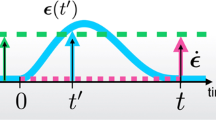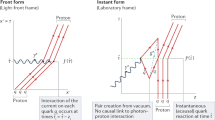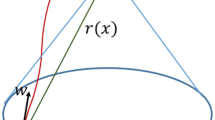Abstract
EXCEPT for a gauge-fixing condition, Dirac's recent theory1–3 corresponds to the natural form of Maxwell–Lorentz electrodynamics for very fine-grained streams of charged corpuscles all with the same constant mass μ and charge ε; the velocity field in the stream is supposed to be continuous and differentiable. The ratio μ′/ε is written k; here μ′ is the measure of μ in energy units: μ′ ≡ μc2. (We call this first special form of the theory the superconductive theory, since its equations will be seen to be entirely equivalent to those of the relativistic form of the Maxwell–London theory when only supercurrents are present. As not all electrodynamics is superconductive, this theory is insufficiently general.) It is evident intuitively that in the uniform stream theory3, where μ and ε are everywhere constant, a non-trivial electrostatics is impossible; for example, it is not possible to describe as a static situation a charged dielectric, or any system with a space-charge which appears at rest macroscopically. For this and other reasons, connected with the existence of more than one kind of elementary particle, one is led to generalize the prequantum theory by allowing the mass μ and charge ε to be variable in space-time. Such a theory may be called the general stream theory, and will be considered elsewhere. Here we confine ourselves to discussing some characteristic physical consequences of (a) the equations of motion, and (b) the gauge condition of the uniform stream theory. These follow from the assumption of:
This is a preview of subscription content, access via your institution
Access options
Subscribe to this journal
Receive 51 print issues and online access
$199.00 per year
only $3.90 per issue
Buy this article
- Purchase on Springer Link
- Instant access to full article PDF
Prices may be subject to local taxes which are calculated during checkout
Similar content being viewed by others
References
Dirac, P. A. M., Proc. Roy. Soc., A, 209, 291 (1951).
Dirac, P. A. M., Nature, 168, 906 (1951); 169, 146 (1952). LeCouteur, K. J., Nature, 169, 146 (1952).
Dirac, P. A. M., Proc. Roy. Soc., A, 212, 330 (1952).
Private discussion with B. Podolsky. If only the charge and current densities are considered, the difficulties may be obviated: Physical Review, 72, 624 (1947).
Born, M., Nature, 169, 1105 (1952).
London, F., “Superfluids”, 1, 29 (Wiley, New York, 1950).
Author information
Authors and Affiliations
Rights and permissions
About this article
Cite this article
MELVIN, M. The New Classical Electrodynamics. Nature 171, 890–892 (1953). https://doi.org/10.1038/171890b0
Issue Date:
DOI: https://doi.org/10.1038/171890b0
This article is cited by
-
On the theory of inertial gravitational fields
General Relativity and Gravitation (1975)
-
Variational principles in the theory of gravitoinertial fields
Soviet Physics Journal (1974)
Comments
By submitting a comment you agree to abide by our Terms and Community Guidelines. If you find something abusive or that does not comply with our terms or guidelines please flag it as inappropriate.



